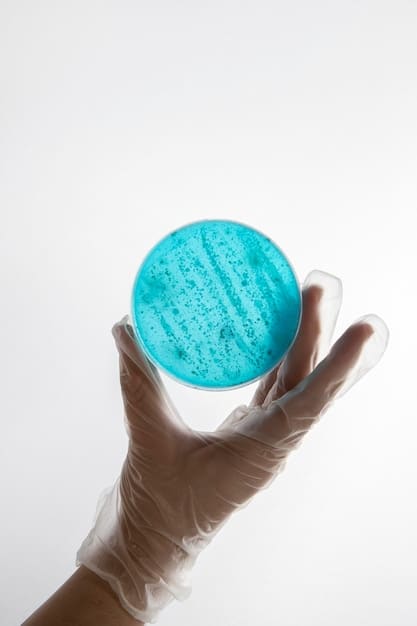Is the New At-Home Colon Cancer Screening Test Right For You in 2025?

The emergence of new at-home colon cancer screening tests in 2025 offers a convenient and accessible option for early detection, potentially increasing screening rates and improving health outcomes for many individuals who might otherwise delay or avoid traditional clinical procedures.
As we advance into 2025, a significant shift is underway in preventive healthcare, particularly concerning colorectal cancer. The question on many minds is: Is the New At-Home Colon Cancer Screening Test Right for You in 2025? This new generation of tests promises unprecedented convenience, potentially revolutionizing how we approach this critical health screening.
Understanding the Landscape of Colon Cancer Screening in 2025
The fight against colon cancer has always prioritized early detection. Historically, colonoscopies have been the gold standard, offering both diagnostic and preventative capabilities. However, their invasive nature and the logistical hurdles involved often deter many eligible individuals from undergoing screening.
In 2025, the medical landscape has evolved, introducing a broader range of screening options. These advancements aim to bridge the gap between necessary preventative care and patient comfort, providing more accessible avenues for early detection.
The Shift Towards At-Home Convenience
The push for at-home testing is not merely about comfort; it’s about accessibility and public health. Many individuals, especially those in rural areas or with limited access to specialized medical facilities, face significant barriers to traditional screenings. At-home tests offer a viable solution, empowering people to take control of their health without extensive travel or time off work.
This shift reflects a broader trend in healthcare towards patient-centric models, where technology facilitates easier engagement with preventative measures. The idea is to make screening as routine and straightforward as possible, integrating it into daily life rather than treating it as a complex medical procedure.
Several factors contribute to the growing popularity of at-home colorectal cancer screening tests:
- Reduced inconvenience: No need for extensive bowel preparation or sedation.
- Increased privacy: Samples can be collected in the comfort of one’s home.
- Accessibility: Beneficial for individuals with mobility issues or living far from clinics.
- Potential for higher adherence rates: Easier access may lead to more people getting screened.
While the convenience is undeniable, understanding the nuances of these tests—their accuracy, limitations, and suitability for different risk profiles—is crucial. They are not a one-size-fits-all solution, and their appropriate application hinges on individual circumstances and medical advice.
Ultimately, the goal is to save lives through early detection. The expanded array of screening methods in 2025 provides more pathways to achieving this, addressing unique patient needs and preferences while maintaining the highest standards of diagnostic efficacy.
How the New At-Home Colon Cancer Screening Tests Work
The at-home colon cancer screening tests available in 2025 primarily leverage advanced molecular analysis or highly sophisticated immunochemical detection methods. Unlike older tests that merely looked for microscopic blood, these new versions delve deeper into biological markers, significantly enhancing their accuracy and predictive value.
Most of these tests fall into two main categories: stool DNA tests and highly sensitive fecal immunochemical tests (FIT). Both are designed to detect early signs of colorectal cancer or pre-cancerous polyps by analyzing samples collected at home.
Stool DNA Tests: Unpacking the Genetic Clues
Stool DNA tests, such as the widely recognized multi-target stool DNA (mt-sDNA) tests, analyze DNA shedding from the lining of the colon into the stool. As polyps or tumors grow, they can shed abnormal cells containing mutated DNA into the stool. These tests are designed to detect these specific genetic alterations associated with colorectal cancer.
The process is remarkably simple from the user’s perspective. A kit is mailed to the individual’s home, where they collect a small stool sample using provided materials. The sample is then securely packaged and sent back to a specialized laboratory for analysis. The lab extracts and analyzes the DNA for mutations commonly found in colon cancer cells or polyps.
The sensitivity of these tests has dramatically improved, capable of identifying a higher percentage of cancers and advanced pre-cancerous lesions compared to earlier generations. This makes them a powerful tool for early detection, particularly for individuals who are hesitant about traditional colonoscopies.
Fecal Immunochemical Tests (FIT): Advanced Blood Detection
While FIT tests are not entirely new, the versions available in 2025 represent a significant leap forward in sensitivity and specificity. These tests detect hidden blood in the stool, which can be an indicator of polyps or cancer. Unlike older fecal occult blood tests (FOBT) that could be affected by diet, modern FIT tests specifically target human hemoglobin (the protein in red blood cells), making them much more accurate and less prone to false positives.
The at-home procedure involves collecting a small stool sample, which is then sent to a lab for analysis. The lab uses antibodies to detect minute amounts of human blood in the sample. A positive result indicates the presence of blood, necessitating further investigation, typically with a colonoscopy.
The ease of use and improved accuracy make FIT tests a convenient and effective initial screening option for many people. They serve as a crucial first step in identifying individuals who may require more invasive follow-up procedures.

Both types of tests offer a non-invasive, user-friendly approach to colon cancer screening. While they do not replace the diagnostic capabilities of a colonoscopy, they serve as excellent screening tools, identifying individuals who may benefit from further investigation. Understanding their mechanisms helps individuals make informed decisions about their healthcare journey.
Effectiveness and Accuracy: What to Expect from At-Home Kits
When considering any medical test, effectiveness and accuracy are paramount. For the new at-home colon cancer screening tests in 2025, these attributes have seen remarkable improvements, offering a reliable, albeit distinct, screening experience compared to traditional methods.
It’s vital to recognize that “effectiveness” in this context refers to the test’s ability to detect colorectal cancer or pre-cancerous conditions, while “accuracy” pertains to its sensitivity (correctly identifying those with the condition) and specificity (correctly identifying those without the condition).
Understanding Sensitivity and Specificity
The latest at-home stool DNA tests boast high sensitivity for detecting both colorectal cancer and advanced adenomas (pre-cancerous polyps). This means they are very good at identifying individuals who have these conditions, reducing the chance of a false negative.
For example, some multi-target stool DNA tests have reported sensitivities for colorectal cancer upwards of 90%, meaning they correctly identify cancer in 9 out of 10 people who have it. Their ability to detect advanced adenomas, though slightly lower, is still significant, catching a good proportion of these important precursors to cancer.
However, these tests also have a certain rate of false positives – where the test indicates an abnormality when none exists. A positive result from an at-home test always necessitates a follow-up colonoscopy to confirm the findings and remove any detected polyps. This is a critical point: a positive at-home test is a signal for further investigation, not a definitive diagnosis of cancer.
FIT Tests: Rapid and Reliable
Modern FIT tests have also achieved impressive levels of accuracy. While they primarily detect blood, their enhanced sensitivity means they can pick up even trace amounts that might indicate a problem. They are highly specific for human blood, minimizing false positives from dietary sources or medications.
The frequency of FIT testing is typically annual, given that bleeding from polyps or cancers can be intermittent. Consistent, yearly testing significantly increases the chances of early detection over time.
A key difference between stool DNA tests and FIT tests lies in what they detect. Stool DNA tests look for genetic changes, offering a broader scope in identifying both cancerous cells and advanced polyps. FIT tests, on the other hand, focus on blood, which may not always be present in early stages of some cancers or polyps.
Comparative Effectiveness
While a colonoscopy remains the most comprehensive method, capable of both detecting and removing polyps in one procedure, at-home tests serve a crucial role as excellent screening tools. They are particularly effective for individuals at average risk who might otherwise forgo screening due to the invasiveness or inconvenience of a colonoscopy.
The effectiveness of at-home tests should be viewed within the context of a tiered approach to screening. A negative result provides reassurance (though periodic rescreening is still necessary), while a positive result acts as an urgent call for a definitive diagnostic colonoscopy. This layered approach maximizes detection while minimizing barriers to initial screening.
It’s essential to discuss with a healthcare provider which at-home test, if any, is most appropriate based on individual risk factors, medical history, and personal preferences, ensuring that the chosen screening method aligns with best medical practices.
Who Should Consider At-Home Screening in 2025?
The availability of new at-home colon cancer screening tests in 2025 vastly expands options for early detection, but they are not universally suitable for everyone. Determining if these tests are right for you largely depends on your individual risk factors and screening history.
Generally, at-home screening tests are recommended for individuals who are at average risk for colorectal cancer. This typically includes adults aged 45 and older with no personal or family history of colorectal cancer, polyps, or certain inflammatory bowel diseases.
Average-Risk Individuals: A Convenient First Step
For those falling into the average-risk category, at-home tests offer a highly convenient and less invasive alternative to traditional colonoscopies. They serve as an excellent primary screening method, especially for people who are reluctant to undergo a colonoscopy due to its preparation, sedation, or the procedure itself.
The ease of sample collection in the privacy of one’s home can significantly increase adherence to screening guidelines, which is a major public health goal. Many people who might otherwise defer screening due to busy schedules or discomfort with clinical procedures may find these at-home options more appealing and manageable.
It’s important for average-risk individuals to understand that a positive result from an at-home test does not mean they have cancer, but rather that a follow-up colonoscopy is necessary to investigate the cause of the positive result. This crucial next step confirms findings, diagnoses conditions, and allows for the removal of polyps.
Consider at-home screening if you meet these criteria:
- You are 45 years or older.
- You have no personal history of colorectal cancer.
- You have no personal history of inflammatory bowel disease (Crohn’s disease or ulcerative colitis).
- You have no personal history of certain genetic syndromes that increase colon cancer risk (e.g., Lynch syndrome, FAP).
- You have no close family history of colorectal cancer or advanced polyps.
When At-Home Tests May Not Be Suitable
Conversely, for individuals at increased or high risk for colorectal cancer, at-home tests are generally not recommended as the primary screening method. High-risk factors include:
- A family history of colorectal cancer or certain types of polyps.
- A personal history of inflammatory bowel disease (Crohn’s disease or ulcerative colitis).
- A personal history of certain genetic syndromes (e.g., Lynch syndrome, Familial Adenomatous Polyposis).
- A personal history of previous colon cancer or certain types of polyps.
In these cases, a colonoscopy is typically the preferred screening method because it not only detects abnormalities but also allows for immediate biopsy and removal of polyps. For high-risk individuals, the ability to directly visualize the colon and intervene if necessary is paramount, and at-home tests may not provide the necessary level of diagnostic detail or intervention capabilities.

Ultimately, the decision to use an at-home screening test should be made in consultation with a healthcare provider. They can assess your individual risk profile, discuss the pros and cons of various screening options, and help you choose the most appropriate path for your health in 2025 and beyond.
Preparing for Your At-Home Colon Cancer Test: A Step-by-Step Guide
One of the appealing aspects of the new at-home colon cancer screening tests is their relative simplicity in preparation compared to a full colonoscopy. However, ‘simple’ does not mean ‘no preparation.’ Adhering to the instructions meticulously is crucial for obtaining accurate results.
The specific preparation steps will vary slightly depending on the type of at-home test you receive (stool DNA vs. FIT). Always read the enclosed instructions from the manufacturer thoroughly before beginning. Disregarding instructions can lead to invalid results or the need for re-testing.
General Guidelines for Preparation
Regardless of the test type, maintaining clear communication with your healthcare provider is key. If you have any medical conditions, are taking medications, or have specific dietary restrictions, discuss these with your doctor before starting the test. While most at-home stool tests are less sensitive to dietary influences than older tests, confirming any potential interactions is good practice.
The main preparation involves understanding the collection process and ensuring the sample is handled correctly. Here’s a general outline of steps you can expect for most at-home colon cancer screening kits:
- Receive the Kit: The kit will be delivered to your home, typically containing the collection device, a sample container, clear instructions, and a return mailer.
- Read Instructions Carefully: Before doing anything, read the entire instruction manual. Pay attention to diagrams and specific timings.
- No Special Diet (for most new tests): Unlike older tests, the new generation of stool DNA and FIT tests generally do not require strict dietary restrictions. However, always confirm with your specific test’s instructions as minor recommendations might exist.
- Collect the Sample: This is the core step. You’ll use the provided device to collect a small stool sample. The method ensures hygienic and accurate collection without direct contact. Some devices collect a portion or scrape, while others might involve a swab.
- Secure the Sample: Immediately after collection, the sample needs to be placed into the provided container and sealed tightly to prevent contamination and leakage.
- Prepare for Shipping: Place the sealed sample container into the biohazard bag and then into the pre-addressed, prepaid return mailer. Ensure all necessary forms (if any) are included.
- Mail the Sample Promptly: Most tests recommend mailing the sample within a specific timeframe (e.g., 24-48 hours) to ensure sample integrity. Find the nearest designated drop-off location or pick-up service as instructed.
Important Considerations Before and During the Test
Avoid collecting a sample if you are experiencing active bleeding from hemorrhoids, menstruating, or have blood in your urine, as this could lead to a false positive result. Wait until these conditions have resolved before collecting the sample. Ensure the sample is not contaminated with toilet water or urine.
For some tests, storing the sample correctly—such as in a refrigerator—before mailing is crucial. Pay close attention to these storage instructions. Never expose the sample to extreme temperatures.
Following these preparation and collection guidelines diligently maximizes the test’s accuracy and reduces the likelihood of needing a repeat test. The goal is to make the process as straightforward and effective as possible, contributing to your peace of mind and early detection efforts.
Interpreting Your Results and Next Steps
Receiving results from any medical test can be a moment of anticipation. For the new at-home colon cancer screening tests in 2025, understanding what your results mean and the appropriate next steps is crucial. These tests provide screening information, not a definitive diagnosis, and positive results always warrant further investigation.
Your test results will typically be communicated to you by your healthcare provider, often accompanied by explanations and recommendations. It’s vital to discuss these results thoroughly with your doctor to fully grasp their implications.
Understanding a Negative Result
A negative result from an at-home colon cancer screening test means that no signs of cancer or pre-cancerous polyps were detected at the time of the test. While this is certainly reassuring, it does not mean you are immune to colon cancer.
It’s important to remember that false negatives can occur, where an abnormality might be present but the test doesn’t detect it. For stool DNA tests, a negative result typically suggests that re-screening should occur every one to three years, depending on the specific test and your risk profile. For FIT tests, annual screening is generally recommended.
Continuing regular screening as recommended by your doctor is essential, as colon cancer often develops slowly, and subsequent tests can detect changes that were not present previously. A negative result is a green light to continue with routine preventative care according to established guidelines.
Interpreting a Positive Result
A positive result from an at-home colon cancer screening test indicates that the test detected markers that could be indicative of cancer or pre-cancerous polyps. This is NOT a diagnosis of cancer, but rather a strong signal that further diagnostic action is necessary.
If your at-home test yields a positive result, the immediate next step is almost always a diagnostic colonoscopy. This procedure allows a gastroenterologist to visually examine the entire colon and rectum, identify the source of the positive finding (e.g., polyps, inflammation, or cancer), and, if necessary, remove polyps or take biopsies for further analysis. Only through a colonoscopy can a definitive diagnosis be made.
It’s natural to feel anxious about a positive result, but try to remember that these tests are designed to catch potential problems early. Early detection significantly improves treatment outcomes for colorectal cancer. Many positive results from screening tests turn out not to be cancer or are due to easily treatable conditions like small, benign polyps or hemorrhoids.
Beyond the Results: Proactive Health Management
Regardless of your test results, engaging in proactive health management is always advised. This includes maintaining a healthy lifestyle, understanding your family medical history, and staying in regular communication with your healthcare provider about any changes in your health or new symptoms.
The introduction of these new at-home tests in 2025 is a powerful stride in public health, making screening more accessible. However, they are part of a larger continuum of care. Understanding the results and diligently pursuing recommended follow-up actions ensures that the convenience of an at-home test translates into effective preventative healthcare.
The Future of Colon Cancer Screening: Innovations Beyond 2025
As we look beyond 2025, the field of colon cancer screening continues to evolve at a rapid pace, driven by technological advancements and a deeper understanding of human biology. The at-home tests available today are just a stepping stone to even more sophisticated and personalized screening methods on the horizon.
Future innovations aim to enhance accuracy, reduce invasiveness even further, and integrate screening into broader digital health platforms, making it an almost seamless part of routine health management. The goal remains the same: to detect colorectal cancer as early as possible, ideally even before pre-cancerous lesions fully develop.
Liquid Biopsies: A Glimpse into the Bloodstream
One of the most promising areas of research is the development of liquid biopsies for colon cancer screening. Instead of analyzing stool samples, these tests analyze blood plasma for circulating tumor DNA (ctDNA) or other biomarkers shed by polyps or cancerous cells.
The appeal of liquid biopsies is immense: a simple blood draw could potentially offer a highly accurate, non-invasive screening method. While some liquid biopsies are already used for monitoring cancer recurrence or guiding treatment in diagnosed patients, their application as a primary screening tool for asymptomatic individuals is still under extensive investigation. The challenge lies in achieving sufficient sensitivity to detect very early-stage cancers or pre-cancerous lesions when their DNA shedding into the bloodstream is minimal.
AI and Machine Learning in Diagnostics
Artificial intelligence (AI) and machine learning (ML) are set to revolutionize various aspects of colon cancer screening. In the context of at-home tests, AI could potentially analyze stool samples more effectively, identifying subtle patterns or biomarkers that human analysis or traditional methods might miss.
For colonoscopies, AI-powered systems are already being developed to assist endoscopists in detecting polyps, particularly subtle or flat lesions that are difficult to spot. These systems could enhance the detection rate, reducing the chances of missed abnormalities during endoscopic procedures.
Personalized Screening Strategies
The future of screening is increasingly personalized. Genetic profiling, combined with lifestyle data and environmental factors, could allow for highly tailored screening recommendations. Instead of broad age-based guidelines, individuals might receive screenings at specific intervals or using particular methods based on their unique risk profile.
This approach could involve integrating data from genomic tests, microbiome analysis (understanding the bacteria in the gut), and even wearable technology to identify individuals at higher risk for colorectal cancer and recommend precise, timely interventions.
Innovations also include enhanced imaging techniques that are less invasive than traditional colonoscopies, such as advanced computed tomography colonography (CTC) with reduced radiation, or even ingestible capsules that provide detailed images of the colon.
The trajectory of colon cancer screening is clear: more accessible, more accurate, and more personalized over time. These future advancements promise to make early detection even more achievable, playing a critical role in reducing the burden of colorectal cancer worldwide.
| Key Aspect | Brief Description |
|---|---|
| 🏠 At-Home Convenience | New tests offer easy stool sample collection at home, increasing accessibility for many. |
| 🔬 Test Types | Primarily highly sensitive FIT (fecal immunochemical tests) and multi-target stool DNA tests. |
| ✅ Accuracy & Role | High efficacy for screening average-risk individuals; a positive result necessitates a follow-up colonoscopy. |
| 🌐 Who Benefits Most | Ideal for average-risk individuals reluctant to undergo traditional colonoscopies due to convenience or fear. |
Frequently Asked Questions About At-Home Colon Cancer Screening in 2025
The primary benefit is convenience and non-invasiveness. At-home tests eliminate the need for extensive bowel preparation, sedation, and a clinic visit, making screening more accessible and much less intimidating for many individuals. This ease of use can significantly increase screening adherence, leading to earlier detection rates.
At-home tests are highly accurate for screening purposes, especially for detecting cancers and advanced polyps. However, they are screening tools, not diagnostic ones. A colonoscopy remains the gold standard because it allows direct visualization, biopsy, and immediate removal of polyps, which at-home tests cannot do.
Individuals at increased risk for colorectal cancer, such as those with a personal or strong family history of the disease, certain genetic syndromes, or inflammatory bowel disease, should not rely on at-home tests. For these groups, a colonoscopy is usually the recommended primary screening method due to its diagnostic and interventional capabilities.
A positive result from an at-home test indicates that potential markers of colon cancer or precancerous conditions were detected. This does not mean you have cancer, but it absolutely requires a follow-up diagnostic colonoscopy. The colonoscopy will confirm the finding, identify the source of the abnormality, and allow for any necessary interventions like polyp removal.
The frequency depends on the specific type of at-home test and your individual risk factors. Generally, multi-target stool DNA tests are recommended every 1 to 3 years for average-risk individuals, while highly sensitive fecal immunochemical tests (FIT) are often recommended annually. Always follow your healthcare provider’s specific guidance.
Conclusion
The advent of new at-home colon cancer screening tests in 2025 marks a transformative period in preventative healthcare. These innovative options offer unprecedented convenience and accessibility, potentially empowering millions of Americans to engage in crucial early detection efforts. While they provide a vital pathway for average-risk individuals who might otherwise defer screening, it’s paramount to remember their role as screening tools, not definitive diagnostic instruments. A positive result necessitates a follow-up colonoscopy—a crucial step for a precise diagnosis and effective intervention. Ultimately, by embracing these advancements and consulting with healthcare professionals, we can collectively enhance early detection rates, significantly improving outcomes in the ongoing fight against colorectal cancer.





